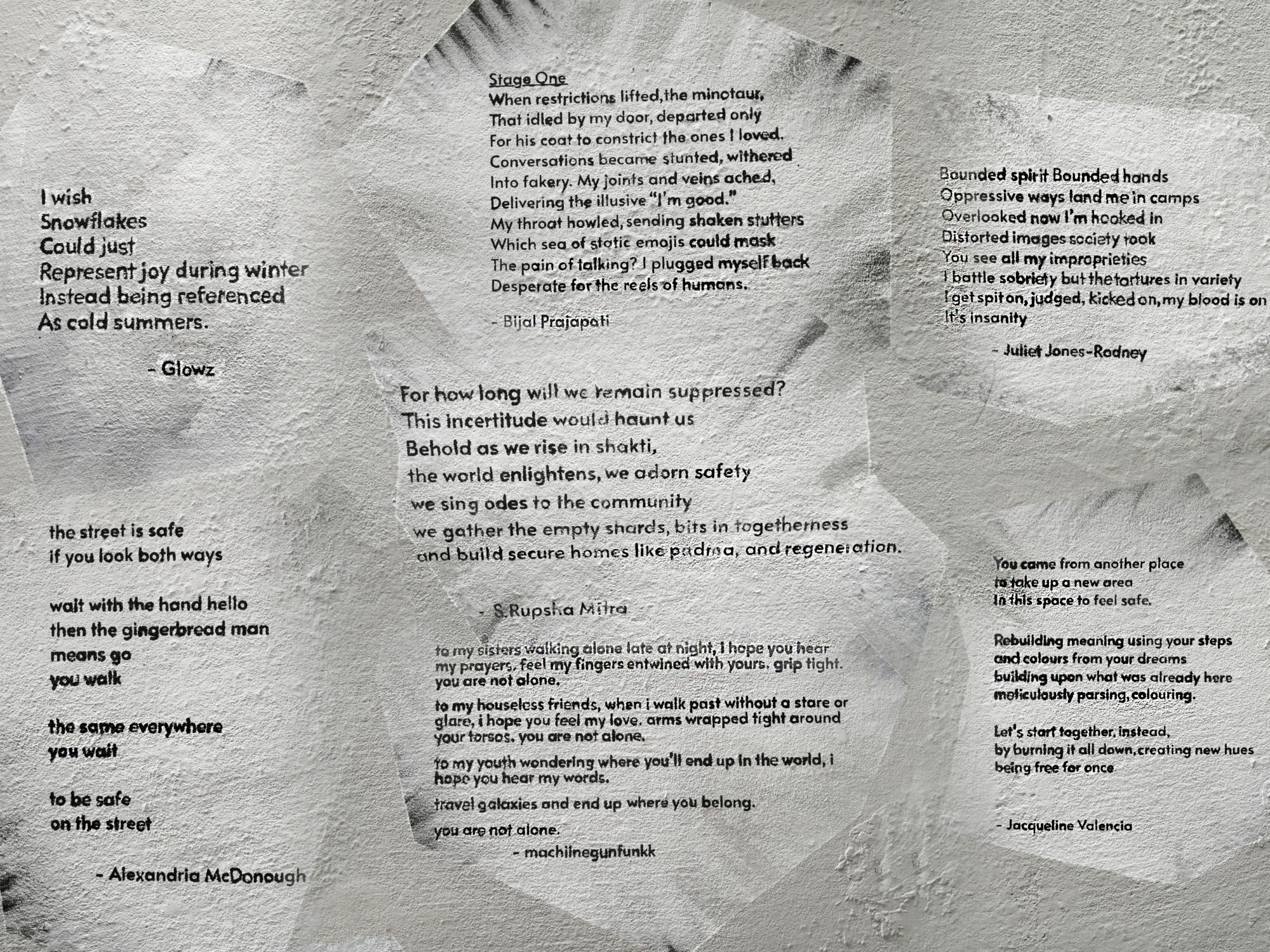
Who Counts? A poetic Interrogation into Public Safety
Published Date: Aug. 31 2022
Image: Penny Xie
In a narrow alley besides Arts Etobicoke, seven poems have a vibrant conversation.
Created by the InPrint Collective in 2021, Poetry InPrint: In the Streets is a dialogue about public safety through screenprinted poems, temporary versions of which were silkscreened in glow in the dark ink on nearby sidewalks last September. Their permanent counterparts stand here, hidden and partially overshadowed by an extravagant Dionne Brand mural on the opposing wall.
The poems themselves were written by contributors Jacqueline Valencia, Gloria O’koye (aka Glowz), Jadyn Hardie-Bardy (aka machiinegunfunk), Bijal Prajapati, Alexandria McDonough, S. Rupsha Mitra, and Juliet Jones-Rodney. Each had a slightly different approach to the concept of public safety, which allows the works together to read as a malleable discourse, the viewer entering a dynamic seminar. Further deepening the conversation, the project has an accompanying series of blog posts, of which most of the poets have explained the perspective behind their work.

Collage of the seven poems printed on the wall. photo credit: Penny Xie
In the first, Bijaj Prajapati describes how she wished to focus on the pandemic’s effect on mental health and how it exacerbated barriers to communication, isolation reframing socialization as unsafe. In another, Juliet Jones-Rodney approaches the project from the perspective of lacking, the ever-present danger of being a woman and a person of colour. She writes, “I’m if honest I don’t know what safety is / That’s a privilege being a black woman doesn’t give”, continuing on to express fears of disappearance, societal uncaring, and pervasive nature of the male gaze, and ending with the statement “safety doesn’t belong to me”.
Almost transitioning from this thought, fellow poet S. Rupsha Mitra explains in her post that she approaches safety as a form of rallying cry, something that needs to be ensured for the marginalized through the concept of ‘the unruly woman’, through “raising our voices . . . transcending the barricades.” Following this, Gloria O’koye discusses how she moves towards public safety in a multi-faceted context, acknowledging it’s individualistic meaning and focusing her representation on reclaiming safety in places where it feels lost, expressing how her own sense of it was damaged when she lost a friend to gun violence earlier in the year.
In a final aside, author and poet mentor Jacqueline Valencia speaks of both her writing and that of her daughter, Alexandria McDonough, who is a low-verbal autistic adult. Alexandria’s poem gives insight into her experience interacting with the world as an individual with a disability, Jacqueline elaborating that “(w)hen you read the poem you’re going through a run through of how Alexandria sees crossing the street as visuals.” She explains that the project gave her daughter a chance to be part of a conversation and represent a less discussed aspect of public safety.
The final result of this work is a piece that feels very conversational and collaborative, even beyond the work of the artists themselves. The intimate placement and inherent concept feel primed to bring passers-by into the conversation and have them interrogate their own relationship with public safety, adding to collective thought through determined presencing. It is both richly in the moment and beyond it, addressing our immediate anxieties in an unprecedented time while also reminding us of the continuous fight for a public in which all of us are truly safe.





